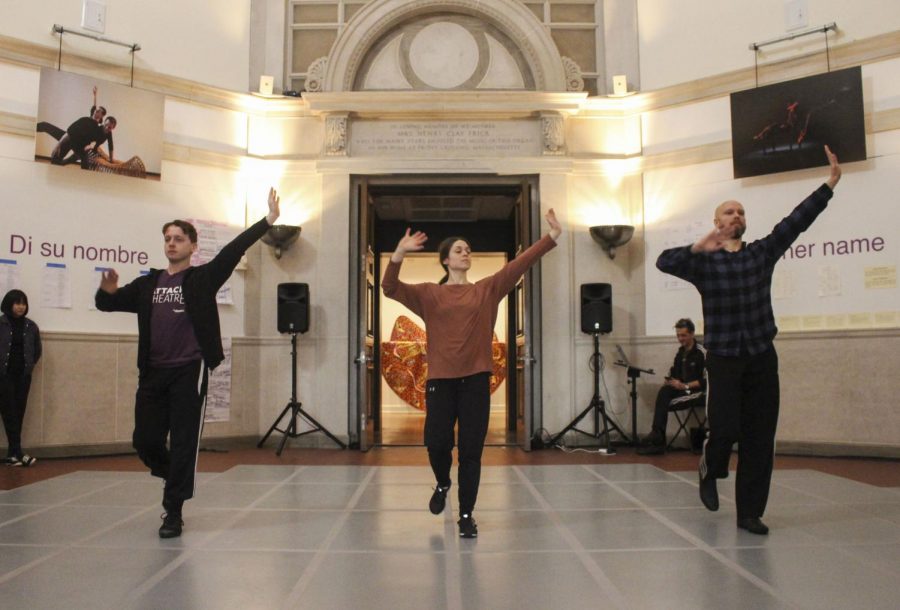Year of Creativity helps Pitt explore its artistic side
Hannah Heisler | Senior Staff Photographer
Members of Attack Theatre, a Pittsburgh-based dance company, begin a February open rehearsal in the Frick Fine Arts University Gallery. The event is sponsored by Pitt’s Year of Creativity and is meant to showcase the process of dancemaking.
May 11, 2020
A sculpture that shows campus energy usage in real-time. A journal about Tourette syndrome. A group of people dancing the Time Warp under the Cathedral of Learning.
Despite these projects’ varying themes, they all have one element in common — providing a creative outlet for students. The projects are some of the hundreds that formed the Year of Creativity, the incarnation of the Year Of series which took place during the 2019-20 academic year. The Year was launched in an effort to encourage learning across disciplines for students and faculty.
Provost Ann Cudd said the Year was a big success on campus.
“I think it generated a tremendous amount of enthusiasm and creativity,” Cudd said.
Cudd added that though the Year, and the rest of the University, have moved online due to the ongoing COVID-19 pandemic, students are still keeping up their artistic side.
“I’m amazed at how well they’ve been able to do stuff,” Cudd said. “There’s no lack of creativity in all of the virtual art and music and performance that people have been able to create.”
Kit Ayars, a co-chair of the Year of Creativity’s steering committee, said one of the goals of the Year was to demonstrate that creativity did not just belong to more traditional liberal arts parts of campus.
“Creativity is not just something that belongs to fine arts departments, for instance, but it’s something that’s at the core of the University’s mission in things like the sciences,” Ayars, the Center for Creativity’s director of strategy of partnerships, said.
Jeanne Marie Laskas, a co-chair of the Year of Creativity’s steering committee, said the Year provided an excellent opportunity for community members to recognize Pitt as a hub of creative work.
“As a University, that’s not the first thing that comes to people’s minds. Maybe it’s more science or medicine,” Laskas, a distinguished professor of English and founding director at the Center, said. “At our core, this is a creative powerhouse.”
Laskas added that 89 projects were funded through the Year’s competitive grant process, through which initiatives could receive up to $5,000. Students in the schools of Arts and Sciences, Engineering, Social Work, Health and Rehabilitation Sciences and several others submitted proposals.
“It was really kind of thrilling just to receive this wash of proposals,” Laskas said.
Some parts of the Year of Creativity will live on past April. Cudd said the Center, which hosted many of the Year’s events, has also gained more visibility on campus. Pitt also formed a Public Art Steering Committee in late January which will review proposals for new art on campus and guide a strategic approach for public art.
“Whenever somebody wants to propose a bit of public art, this committee will be there to help,” Cudd said. “I think that adds a lot to our campus master planning.”
As the spring semester began to draw to a conclusion, preparations started for the next installation of the “Year of” series. Cudd announced in April that the 2020-21 academic year would be the “Year of Engagement,” to be led by Senior Vice Chancellor for Engagement Kathy Humphrey, and focused on civic, campus and community engagement. Cudd said the Year will build on recent engagement projects, such as the recent openings of the Community Engagement Centers and other efforts.
“We’ve really been building a lot of momentum on that. This proposal by the students really crystallized it in my mind,” Cudd said. “I think it’s actually a perfect time for the Year of Engagement.”
She said the idea came from three current or former members of Student Government Board — Cedric Humphrey, Kathryn Fleisher and Scott Glaser. Humphrey, the current SGB executive vice president, said the idea was borne out of SGB’s Pitt Civics Task Force and driven by a desire for community-building.
“We just want to keep advocating for civic engagement across the board,” Humphrey, a rising senior political science and economics major, said. “Whether that be direct service, philanthropy, advocacy, grassroots, all across the board.”
Humphrey added that the Year is set to harness growing political activity on campus, due to the upcoming 2020 presidential election in November and the ongoing 2020 Census count.
“We thought now would be the best time to really empower student organizations, empower faculty, to put on any events they would like,” Humphrey said. “I think the best way the University could support that effort is to provide anybody within our Pitt community with the tools that they need to advocate for engagement.”
But Humphrey said the Year also highlights an important need for a Pitt education to be multidimensional, and not just focus on academics.
“We feel that students at this university are getting a great education, but we should be doing a little more for them,” Humphrey said. “We should be making sure they are prepared to be active citizens once they graduate, in whatever capacity that may be. When students come to the University of Pittsburgh, they should leave here understanding what it feels like and what it means to be part of a greater community.”
Even if the Year can’t happen physically on campus due to the pandemic, Humphrey said the crisis demonstrates how important the Year’s theme — engagement — is to people.
“I think there’s an opportunity that, if we are not back on campus next year, for the Year of Engagement to really thrive within that,” Humphrey said. “We’re going to have to come together to overcome the effects of this pandemic.”



